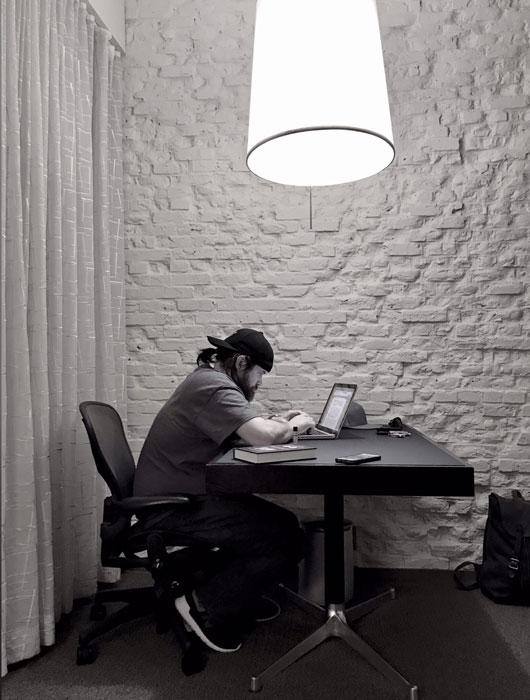Owner, Brown Dog Welding
- FMA
- The Fabricator
- FABTECH
- Canadian Metalworking
Categories
- Additive Manufacturing
- Aluminum Welding
- Arc Welding
- Assembly and Joining
- Automation and Robotics
- Bending and Forming
- Consumables
- Cutting and Weld Prep
- Electric Vehicles
- En Español
- Finishing
- Hydroforming
- Laser Cutting
- Laser Welding
- Machining
- Manufacturing Software
- Materials Handling
- Metals/Materials
- Oxyfuel Cutting
- Plasma Cutting
- Power Tools
- Punching and Other Holemaking
- Roll Forming
- Safety
- Sawing
- Shearing
- Shop Management
- Testing and Measuring
- Tube and Pipe Fabrication
- Tube and Pipe Production
- Waterjet Cutting
Industry Directory
Webcasts
Podcasts
FAB 40
Advertise
Subscribe
Account Login
Search
Hungry men and women, sparked by the same fire, won’t stop evolving
- By Josh Welton
- March 20, 2018
- Article
- Arc Welding
Sometime in the middle of the 20th century, four-year universities became a necessity. With the GI Bill after World War II and the global technology race from the 1960s and onward, the U.S. government spent wads of Uncle Sam’s money on grants and scholarships to funnel kids into higher education. Our goals evolved. Instead of the college experience being a true education on an array of subjects, from the mechanical to the physiological to the philosophical, “higher learning” turned into teaching us the basics we missed in high school so we could then focus our attention on that one thing we want to be for the rest of our life. An accountant, a doctor, an engineer.
To latch on to a field and strive for a position in that field is not a bad thing, at least at face value. There’s something noble about a 12-year-old kid playing with LEGO®s, deciding if he or she wants to be an engineer, and then pursuing that goal with all of their energy. Many of us, however, are not wired this way. When I was in high school I wanted to be an architect. And a psychologist. And a philosopher. And a ninja. But I wasn’t really goal-oriented; I just wanted to live. I wanted to experience life. My plan was to go to a traditionally conservative college for two years while studying psychology before transferring to a traditionally liberal school for two years to study architecture. As an 18-year-old, I didn’t realize yet that this just was not how the world worked.
Americans have turned into specialists. Not only that, but we were asked to choose our specialty as teenagers. “So, I know you’re not an adult yet, buuuut ... what do you want to be for the rest of your life?” Not only were we asked to choose a career, but also our identity. That’s a heavy burden for a kid, and not one most are equipped to handle. Especially when you get deep into your major and figure out you hate it. Colleges don’t make it cheap or easy to change course, which can put the student between a rock and a hard place.
As I was thinking on this, a memory from a past road trip swirled around my brain. I was in Maryland for work when we had a long weekend off. I visited my brother, his wife, and their dog in Rhode Island. I drove east to North Adams and checked out the Massachusetts Museum of Contemporary Art, then south to Stockbridge and the Norman Rockwell Museum. Both museums blew away my expectations. On my way back to Aberdeen I stopped at my friend Drew’s place.
I met Drew through Instagram (his name there is now @d.i.m.e.s) and always admired his work. When he invited me to swing by, I jumped at the chance to talk shop with him. Even though we’d just met face to face for the first time, it was more like two old friends connecting with the common bonds of cars, TIG welding, art, and secret squirrel military fabrication work. We talked about the Instagram welding circle fostered by so many talented and hard-working kids, and how it has changed over the last couple of years.
I thought one of his observations was particularly interesting. “Everyone is doing something different now,” as in, so many of the Instagrammers who built the welding community around beautiful beads kind of branched off into different fields. Individuals would find or forge a niche and fill it, becoming blacksmiths, bladesmiths, furniture makers, photographers, and sculptors. Drew himself began creating one-off TIG torch rigs, and others also began catering to our industry by making custom modular hand rests, torch holders, welding carts, PPE, and even consumables. There are a few consultants, salesmen, and others now either running or owning their own shops, focusing more on the business end of things. Hungry men and women who won’t stop evolving, all sparked by the same fire.
Most of us didn’t stop welding; we just added more titles under our name. On top of melting metal I’ve been teaching and writing about cars, life, and, of course, welding. Coming from the other direction are engineers, drivers, chefs, and designers who are attracted to the light. We’ve been given a door to knowledge and techniques through social media and online classes that was previously very difficult to open outside of going to school, joining a trade, or working extensively in the field. Online shopping and near-instant delivery have turned the procurement of tools and equipment into a painless and typically affordable process. Taking a class or course on nearly anything is instantly accessible through the World Wide Web.
There is, however, a hazard in gaining a cursory knowledge of a subject, enough so that it merits a mention. I think the English poet Alexander Pope said it best:
A little learning is a dangerous thing;
drink deep, or taste not the Pierian spring:
there shallow draughts intoxicate the brain,
and drinking largely sobers us again.
I’ve watched that play out in my field when someone takes a beginning TIG course, then becomes intoxicated by this new skill and mistakenly thinks they’re God’s gift to welding. You see it online, where people with shallow understanding are loudly opinionated about very complex subjects, going so far as to write authoritatively on them. We’re all entitled to our opinions, but not at the expense of truth or fact.
One of the more difficult aspects of starting over in a new field, especially if you’ve been successful in past endeavors, is coming to grips with the ideas of humility and failure. We don’t know what we don’t know, and that should be sobering. That being said, none of this should stop us from pursuing new activities or diving into different professions. We just need to be aware that when we jump in the pool, we’re not swimming in the deep end right away.
We are finding that some skills, techniques, and practices transcend trades or art forms, and that can accelerate the learning curve. It could be physical, like how the hand/eye/foot coordination of a drummer is relatable to that of a TIG welder. It could be mental, as self-editing and paring down writing is a very similar exercise to revising a design or omitting superfluous bits of a sculpture. Research indicates that world-class musicians, athletes, and welders develop muscle memory and create pathways through the brain in analogous ways. So while it’s important to cultivate a realistic idea of where we stand in relation to those with much more experience in a field we’re still growing in, many concepts could feel familiar.
All of us have different motivations to broaden our horizons: to ease boredom, to make money, to accept a challenge, to fill a void, to gain understanding, to influence minds. Maybe all of the above. I don’t think the why matters; ultimately, having more people exposed to more ideas will be better for mankind. Ignorance isn’t bliss, it’s a leash holding us back. In this day and age, the excuses for sticking with a career we don’t enjoy are quickly disappearing. The weight of an expensive college tuition and the heavy burden of debt that often follows are no longer a necessity, or even the best option. Try new things. Don’t be afraid to fail. Don’t be afraid to succeed. Be anything.
About the Author

About the Publication
subscribe now

The Welder, formerly known as Practical Welding Today, is a showcase of the real people who make the products we use and work with every day. This magazine has served the welding community in North America well for more than 20 years.
start your free subscription- Stay connected from anywhere

Easily access valuable industry resources now with full access to the digital edition of The Fabricator.

Easily access valuable industry resources now with full access to the digital edition of The Welder.

Easily access valuable industry resources now with full access to the digital edition of The Tube and Pipe Journal.
- Podcasting
- Podcast:
- The Fabricator Podcast
- Published:
- 04/16/2024
- Running Time:
- 63:29
In this episode of The Fabricator Podcast, Caleb Chamberlain, co-founder and CEO of OSH Cut, discusses his company’s...
- Industry Events
16th Annual Safety Conference
- April 30 - May 1, 2024
- Elgin,
Pipe and Tube Conference
- May 21 - 22, 2024
- Omaha, NE
World-Class Roll Forming Workshop
- June 5 - 6, 2024
- Louisville, KY
Advanced Laser Application Workshop
- June 25 - 27, 2024
- Novi, MI


































